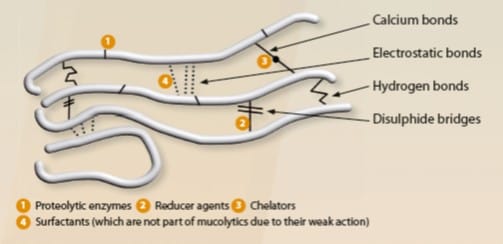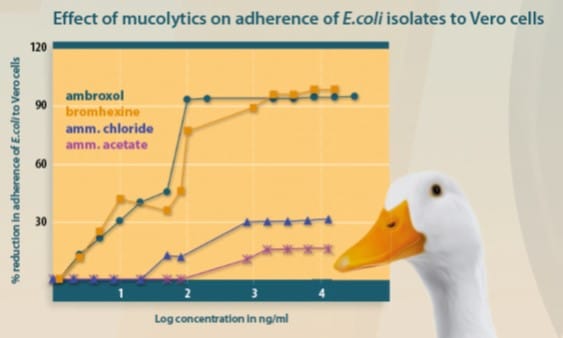Cough: The clinical sign
The cough reflex protects the airways and lungs from airborne and inhaled pathogens, allergens and other irritants.
Mucus is a serological excretion which will help to trap foreign particles and assist with the eliminination from the lungs and airways. However, it may cause difficulties in the normal breathing process. Mucus is an environment for bacterial growth.
To alleviate coughing it is necessary to assist the thinning of mucus, reducing its viscosity and adherence, thus helping expectoration and a return to easy breathing.
ExFlow: The way to productive coughing
The active substance bromhexine is a mucoregulator. By activating the secretion of the seromucous glands, bromhexine helps to re-establish the viscosity and elasticity of bronchial secretions in the tracheobronchial tree. In addition, its expectorant action encourages mobilisation of mucus and enables effective bronchial drainage, thereby improving the functioning and defense capability of the lung.
These two simultaneous actions lead to an abundant discharge and facilitate productive coughing.
Bromhexine is an active substance with a long history. It is supported by 40 years of pharmacological research and clinical development. It is reliable remedy, which helps to clear the airways naturally, reinforcing correspondent body mechanisms. Bromhexine has been demonstrated to be beneficial in the management of acute respiratory tract infections.
Pharmacodynamic properties
A proven mucolytic
Bromhexine breaks disulphide bridges joining the glycoprotein fibers of the mucus, altering its physical properties:
- reduction of mucus viscosity
- decrease of secretions' elasticity
- increase in ciliary mobility
- helps with the thinning of secretions and expectoration
The combination of these actions improves the mucociliary capacity of the animal.
Antioxidant action: additional benefits
In addition to a mucolytic action, ambroxol, the main metabolite of bromhexine, has antioxidant and anti-inflammatory properties.1 It captures free radicals produced in the inflammatory phase and inhibits hyaluronic acid degradation induced injury and improving lesion repair.2
Bacterial anti-adherent effect
Bacterial adherence to tissues is a prerequisite step in the infectious process.
Through changes in the cell surface, bromhexine alters the ability of bacteria (P. aeruginosa, E.coli, S. aureus) to adhere to the upper respiratory tract.3
A reliable mucoregulator
EXFLOW (bromhexine/ambroxol) modifies the synthesis of mucus at cellular level (glandular cells); it works on the transporter that modifies the ionic concentrations in the production of mucus.4
Bromhexine modifies the distribution of antibiotics in the organism and increases their concentration in the respiratory system, thus facilitating their action.5
It may be used in conjunction with antibiotics and/or sulphonamides, bronchodilators. The concomitant administration of bromhexine with antibiotics has enabled a 41% increase in spiramycin concentration in nasal secretions of heifers after two days of treatment. A 25-35% increase of tylosine or erythromycin concentrations in the serum of cows after a single administration was noted. Bromhexine also significantly increased concentrations of tylosin in serum and in nasal secretions of pigs after a single administration. Cmax was 50-70% higher that the Cmax of oxytetracycline administered alone in cows, the absorption half-life was significantly shorter and the elimination half-life was unchanged.
Stimulation of surfactant production (PS): healthier airways
Ambroxol, the main metabolite of bromhexine, was postulated to provide pulmonary surfactant (PS) stimullatory properties and was previously used to prevent surfactant deficiency. Its action helps the regeneration of Type II alveolar cells which produce pulmonary surfactant. This action reduces surface tension and increases surfactant proteins (SP-A and SP-D which are in charge of binding to pathogens and allowing phagocytosis).
This contributes to immune response and leads to easier breathing.6
References:
1. Stetinova V. et al. (2004) In vitro and in vivo antioxidant activity of ambroxol. clin Exp Med 4:152-158. 2. Nowak D. et al. (1994) Antioxidant properties of ambroxol. Free radical Biology and Medicine 16:517-522. 3. Hafez M. et al. (2009) Mucolytics Against Bacterial Adherence to Mammalian Cells. Appl Biochem Biotechnol 158: 97-112. 4. Sumano H. et al. (1995) Use of abroxol and bromhesine as mucolytics for enhanced diffusion of furaltadone into tracheobronchial secretions in broilers. British Poultry Science 36:503-507. 5. Bergogne-Berezin E. et al. (1980) Etude de l'influence d'un agent mucolytique (bromhexine) sur le passage de l'érythromycine dans les sécrétions bronchiques. Thérapie 35:705-711. 6. Seifart C. et al. (2005) Cell- specific modulation of surfactant proteins by ambroxol treatment. Toxicology and Applied Pharmacology 203:27-35.

 Corporate Website
Corporate Website
 Africa
Africa
 Argentina
Argentina
 Asia
Asia
 Australia
Australia
 Belgium
Belgium
 Brazil
Brazil
 Bulgaria
Bulgaria
 Canada (EN)
Canada (EN)
 Chile
Chile
 China
China
 Colombia
Colombia
 Denmark
Denmark
 Egypt
Egypt
 France
France
 Germany
Germany
 Greece
Greece
 Hungary
Hungary
 Indonesia
Indonesia
 Italia
Italia
 India
India
 Japan
Japan
 Korea
Korea
 Malaysia
Malaysia
 Mexico
Mexico
 Middle East
Middle East
 Netherlands
Netherlands
 Peru
Peru
 Philippines
Philippines
 Poland
Poland
 Portugal
Portugal
 Romania
Romania
 Russia
Russia
 South Africa
South Africa
 Spain
Spain
 Sweden
Sweden
 Thailand
Thailand
 Tunisia
Tunisia
 Turkey
Turkey
 Ukraine
Ukraine
 United Kingdom
United Kingdom
 USA
USA
 Vietnam
Vietnam



